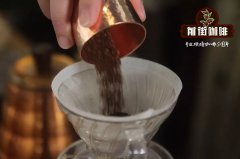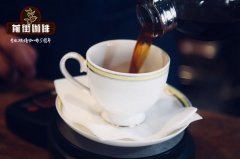Comparison of the five methods of hand-brewing coffee: the difference of continuous water flavor and taste

Professional coffee knowledge exchange more coffee bean information please follow the coffee workshop (Wechat official account cafe_style)
Five ways to make coffee by hand? The difference between hand-brewing coffee and continuous water? What are the skills of making coffee by hand?
The height, velocity and disturbance of the water column are the key factors affecting the hand flushing. The most interesting thing about hand flushing is that it has never had a standard SOP, and any variable may affect the flavor of coffee. This time Goat Coffee will take readers to see the special hand brewing methods such as KONO style, stirring, and automatic hand coffee maker.
Coffee beans: Kenya Nyeri Gatomboya AA
Degree of grinding: Kalita nicecutmill "3"
Water temperature: 88 °C-90 °C
Ratio: 20g:260ml (1:13)
Pre-immersion setting: 40-45ml / 30-35sec five techniques for sailors to make coffee
(1) keep making coffee by sailors)
There is no doubt that six of the ten coffee shops like to use it.
"continuous Water Law"
Most of this technique is classified as "entry level".
Because this technique requires "stable young flow"
It is also the first difficult problem that people who rush their hearts often face.
In the film, you can see that meow fell into the water from the inside to the outside and then went back to circle after the pre-immersion, and stayed in the middle for a long time.
This is because the cooking tools are tapered.
Coffee powder is more in the center and can be extracted more.
So that equilibrium extraction is also the technical point of this technique.
It took about two minutes to cook from start to finish.
This is because the current is slow and young.
Keep the coffee powder soaked, extracted and filtered out of the coffee.
Summary
Advantages: this technique enables coffee to maintain its proper acidity and sweetness (this cup is like a raisin) and its caramel-like aftertaste is longer.
Disadvantages: but body and flavor are not very prominent.
I feel a little pale.
(coffee powder layer after brewing)
(2) Water cut-off method)
When this technique was not popular at first,
Be hailed as an informal technique
This modus operandi when meow first came into contact
It is a lost way to slowly practice its skills.
As a result, I spent more than three months practicing more than ten cups a day.
It's called groping out something.
In the last article "extraction"
It has been mentioned that extracted coffee is divided into three parts: "sour", "sweet" and "bitter".
And the water cut-off method is to strengthen or reduce the weak extraction of each part.
In the film, you can see that meow after pre-immersion
The coffee powder was "tumbled" with a large water column in the first water injection.
And raise the water level.
The second water injection uses a small water column to "tumble" the coffee powder.
This time it is not as exaggerated as the first water injection.
And the water level will not rise more than the coffee powder that has been pushed.
The last water injection uses a small water column to slowly make the coffee powder "soak" rather than "tumble."
"tumbling" is actually a concept of "extraction".
I'm sorry it wasn't mentioned in the last article.
The idea is to stir the coffee powder in the water.
Thus increasing the extraction.
This is like making tea bags.
Both "soaking tea bag" and "stirring tea bag" can also make a cup of tea in the end, but the latter has more extraction.
But it is important to note that coffee is extracted with only 30% soluble flavor.
The rest are insoluble fibres.
If excessive tumbling, there is a chance to make "excessive extraction".
So the first two tumbles are for
Improve the "sour" and "sweet" of extracted coffee
The last bet didn't roll in order not to make the bitterness stand out.
Summary:
Advantages: this technique improves the extraction of sweet and sour parts.
"raisin-like flavor" immediately rose to "blackcurrant juice disadvantage: but aftertaste is relatively short and weak when heated and frozen.
The height, velocity and disturbance of the water column are the key factors affecting the hand flushing. The most interesting thing about hand flushing is that it has never had a standard SOP, and any variable may affect the flavor of coffee. This time Goat Coffee will take readers to see the special hand brewing methods such as KONO style, stirring, and automatic hand coffee maker.
Two major KONO schools: Bengelu VS Kanazawa
Different from the common circular water injection, you may have seen another special hand punching method, which is the unique hand punching method of KONO filter cup, so that the filter paper type hand flushing can also feel the cleanliness and thickness of flannel. However, KONO is not only one-handed, but we will mention the two classic representatives of Bengelu and Kanazawa below.
Benedict drips the water on the coffee powder layer in a drip-by-drop manner, maintaining the central point and avoiding too much disturbance. This kind of hand flushing method requires excellent water control stability, as well as a suitable thin mouth hand flushing pot.
After the coffee powder is soaked, a little coffee is dripped from the bottom, which can be converted into a fine water column, merging the released aromatic substances with the coffee liquid. Finally, the water column is raised and injected with a large amount of water before removing the filter cup, in order to stir up the coffee powder at the bottom and float the foam and fine powder on the surface to avoid the bitterness of the coffee liquid.
In addition, it should be noted that due to the different sizes and concentrations of the three stages of hand brewing, the last coffee must be stirred evenly.
Kanazawa flow: the dragonfly scratches the surface and weighs the front section.
Kanazawa Zhengxing is the ancestor of Kanazawa Liu. this hand-washing method is first steamed, followed by intermittent drips of water, such as dragonflies, to extract coffee liquid with high concentration. The use of this hand method requires the use of a crane-mouth pot to control the amount of water, which focuses on slow water injection to strengthen the extraction of the best flavor of coffee in the front section, replacing the latter section which is prone to coffee impurities and bitterness.
Masuki Kanazawa is a well-known Japanese coffee worker who once worked as a consultant to KONO in Japan. He has also written a book called "delicious Coffee Coffee: delicious Coffee Coffee", which focuses on the manual brewing methods and techniques of KONO filter cups. At present, there is only a Japanese version on the market.
Can stirring replace steaming? Stirring hand flushing method
The stirring method of hand-brewing coffee focuses on "using stirring instead of steaming" to improve the extraction rate. This approach is carried forward by Matt Perger, from Australia, who won the 2012 World Coffee Brewing Competition (WBrC) and the 2013 World Barista Competition runner-up (WBC). He is an influential barista.
Australia's number one barista Matt Perger
The boiling process starts from pouring 50 grams of hot water and stirring, then stands for about 30 seconds, and then injects water with a large water column. If you boil lightly roasted coffee beans, using this hand-brewing method can increase the sweetness and brighten the acidity. Interestingly, Matt Perger also mentioned that in the film he injects water counterclockwise, but if it's in the northern hemisphere, you need to circle clockwise.
The machine replaces the manual automatic coffee maker.
Automatic hand-brewing coffee machines have also been invented in Taiwan. Lin Chih-te, the founder of the coffee maker, spent three years developing the "OTFES", an automatic hand-brewing coffee machine that can control flow rate, water temperature and time. Huang Xiuling, director of black coffee Swing Black, says that the idea of "letting machines do things for people, while people do more important things" is its idea. Hand-made machines are more important to "highlight the value of people," so that more people can enjoy boutique coffee at civilian prices.
Whether it is the KONO school, the stirring hand flushing method, or the most ramming automatic hand punching machine in recent years, it is inseparable from the key point of hand flushing-"people". In order to show rich self-characteristic coffee, and then derived from the advanced techniques or changes. Even for a mechanized hand machine, there must be a hand maker with a core idea behind it, thinking about how the cup of coffee should be presented perfectly.
Important Notice :
前街咖啡 FrontStreet Coffee has moved to new addredd:
FrontStreet Coffee Address: 315,Donghua East Road,GuangZhou
Tel:020 38364473
- Prev

How do you wash Sidamo by hand? The flavor characteristics of washing Sidamo how much is it to wash Sidamo?
Professional coffee knowledge exchange more coffee bean information Please pay attention to Coffee Factory (Wechat official account cafe_style) [Sidamo sidamo] Coffee bean flavor is very diverse, because different soil composition, regional microclimate and countless native coffee varieties make the coffee produced in each urban area have obvious differences and characteristics. Sidamo producing area
- Next

Does Sidamo Coffee Bean Brand recommend Sidamo Coffee? how much is Sidamo Coffee Bean per jin?
Professional coffee knowledge exchange more coffee bean information please follow the coffee workshop (Wechat official account cafe_style) Sidamo coffee beans details: country: Ethiopia level: G1 production area: Sidamo Gujia Chiso micro-production area roasting degree: shallow roasting (end of explosion) treatment: washing variety: original seed producer: local small farmer flavor: lemon, citrus
Related
- Detailed explanation of Jadeite planting Land in Panamanian Jadeite Manor introduction to the grading system of Jadeite competitive bidding, Red bid, Green bid and Rose Summer
- Story of Coffee planting in Brenka region of Costa Rica Stonehenge Manor anaerobic heavy honey treatment of flavor mouth
- What's on the barrel of Blue Mountain Coffee beans?
- Can American coffee also pull flowers? How to use hot American style to pull out a good-looking pattern?
- Can you make a cold extract with coffee beans? What is the right proportion for cold-extracted coffee formula?
- Indonesian PWN Gold Mandrine Coffee Origin Features Flavor How to Chong? Mandolin coffee is American.
- A brief introduction to the flavor characteristics of Brazilian yellow bourbon coffee beans
- What is the effect of different water quality on the flavor of cold-extracted coffee? What kind of water is best for brewing coffee?
- Why do you think of Rose Summer whenever you mention Panamanian coffee?
- Introduction to the characteristics of authentic blue mountain coffee bean producing areas? What is the CIB Coffee Authority in Jamaica?

